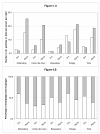Malaria transmission in Libreville: results of a one year survey
- PMID: 22321336
- PMCID: PMC3310827
- DOI: 10.1186/1475-2875-11-40
Malaria transmission in Libreville: results of a one year survey
Abstract
Background: In Gabon, vector transmission has been poorly studied. Since the implementation of the Roll Back malaria recommendations, clinical studies have shown a decline in the burden of malaria in Libreville, the capital city of Gabon. To better understand the transmission dynamic in Libreville, an entomological survey was conducted in five districts of the city.
Methods: Mosquitoes were sampled by human landing collection during 1 year in five districts of Libreville: Alibandeng, Beauséjour, Camp des Boys and Sotega. Mosquitoes were identified morphologically and by molecular methods. The Plasmodium falciparum circumsporozoïte indices were measured by ELISA, and the entomological inoculation rates (EIR) were calculated for all areas. Molecular assessments of pyrethroid knock down resistance (kdr) and of insensitive acetylcholinesterase resistance were conducted.
Results: A total of 57,531 mosquitoes were caught during 341 person-nights (161 person-nights indoor and 180 person-nights outdoor) among which, 4,223 were Anopheles gambiae s.l. The average Human Biting Rate fell from 15.5 bites per person during the rainy season to 4.7 during the dry season. The An. gambiae complex population was composed of An. gambiae s.s molecular form S (99.5%), Anopheles melas (0.3%) and An. gambiae s.s. form M (0.2%). Thirty-three out of 4,223 An. gambiae s.l. were found to be infected by P. falciparum (CSP index = 0.78%). The annual EIR was estimated at 33.9 infected bites per person per year ranging from 13 in Alibandeng to 88 in Sotega. No insensitive AChE mutation was identified but both kdr-w and kdr-e mutations were present in An. gambiae molecular form S with a higher frequency of the kdr-w allele (76%) than the kdr-e allele (23.5%).
Conclusion: Malaria transmission in Libreville occurred mainly during the rainy season but also during the dry season in the five districts. Transmission level is high and seems to be very heterogeneous in the town. Interestingly, the highest EIR was recorded in the most central and urbanized quarter and the lowest in a peripheral area. The decrease of transmission usually seen from peri-urban areas to urban centers is probably more dependent of the socio-economic level of a quarter than of its location in the city. Urban malaria control programmes need to consider the socio economic level of an area rather than the location in the city in order to determine the areas most favourable to malaria transmission.
Figures





Similar articles
-
Systematic Review on Diversity and Distribution of Anopheles Species in Gabon: A Fresh Look at the Potential Malaria Vectors and Perspectives.Pathogens. 2022 Jun 9;11(6):668. doi: 10.3390/pathogens11060668. Pathogens. 2022. PMID: 35745522 Free PMC article. Review.
-
Malaria transmission and insecticide resistance of Anopheles gambiae in Libreville and Port-Gentil, Gabon.Malar J. 2010 Nov 11;9:321. doi: 10.1186/1475-2875-9-321. Malar J. 2010. PMID: 21070655 Free PMC article.
-
Malaria transmission in Dakar: a two-year survey.Malar J. 2008 Sep 16;7:178. doi: 10.1186/1475-2875-7-178. Malar J. 2008. PMID: 18796138 Free PMC article.
-
Role of Anopheles (Cellia) rufipes (Gough, 1910) and other local anophelines in human malaria transmission in the northern savannah of Cameroon: a cross-sectional survey.Parasit Vectors. 2017 Jan 11;10(1):22. doi: 10.1186/s13071-016-1933-3. Parasit Vectors. 2017. PMID: 28077167 Free PMC article.
-
Annual Plasmodium falciparum entomological inoculation rates (EIR) across Africa: literature survey, Internet access and review.Trans R Soc Trop Med Hyg. 2000 Mar-Apr;94(2):113-27. doi: 10.1016/s0035-9203(00)90246-3. Trans R Soc Trop Med Hyg. 2000. PMID: 10897348 Free PMC article. Review.
Cited by
-
Factors contributing to urban malaria transmission in sub-saharan Africa: a systematic review.J Trop Med. 2012;2012:819563. doi: 10.1155/2012/819563. Epub 2012 Oct 18. J Trop Med. 2012. PMID: 23125863 Free PMC article.
-
Assessing Anopheles vector species diversity and transmission of malaria in four health districts along the borders of Côte d'Ivoire.Malar J. 2021 Oct 18;20(1):409. doi: 10.1186/s12936-021-03938-1. Malar J. 2021. PMID: 34663359 Free PMC article.
-
High malaria transmission sustained by Anopheles gambiae s.l. occurring both indoors and outdoors in the city of Yaoundé, Cameroon.Wellcome Open Res. 2018 Dec 23;3:164. doi: 10.12688/wellcomeopenres.14963.1. eCollection 2018. Wellcome Open Res. 2018. PMID: 30756096 Free PMC article.
-
The importance of temperature fluctuations in understanding mosquito population dynamics and malaria risk.R Soc Open Sci. 2017 Mar 8;4(3):160969. doi: 10.1098/rsos.160969. eCollection 2017 Mar. R Soc Open Sci. 2017. PMID: 28405386 Free PMC article.
-
Systematic Review on Diversity and Distribution of Anopheles Species in Gabon: A Fresh Look at the Potential Malaria Vectors and Perspectives.Pathogens. 2022 Jun 9;11(6):668. doi: 10.3390/pathogens11060668. Pathogens. 2022. PMID: 35745522 Free PMC article. Review.
References
-
- Matthys B, Vounatsou P, Raso G, Tschannen AB, Becket EG, Gosoniu L, Cissé G, Tanner M, N'goran EK, Utzinger J. Urban farming and malaria risk factors in a medium sized town in Côte d'Ivoire. AmJTrop Med Hyg. 2006;75:1223–1235. - PubMed
-
- Girod R, Orlandi-Pradines E, Rogier C, Pagès F. Malaria transmission and insecticide resistance of Anopheles gambia (Diptera: Culicidae) in the French military camp of Port-Bouet, Abidjan (Côte d'Ivoire): implications for vector control. J Med Entomol. 2006;43:1082–1087. doi: 10.1603/0022-2585(2006)43[1082:MTAIRO]2.0.CO;2. - DOI - PubMed
Publication types
MeSH terms
Substances
LinkOut - more resources
Full Text Sources

